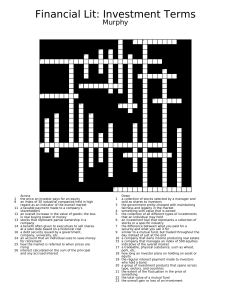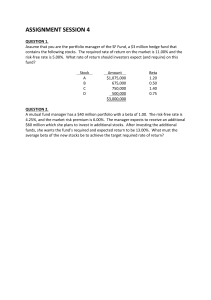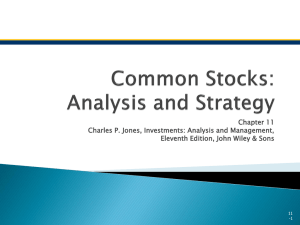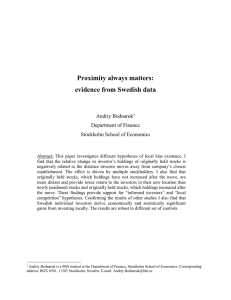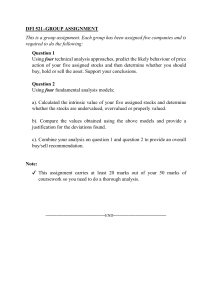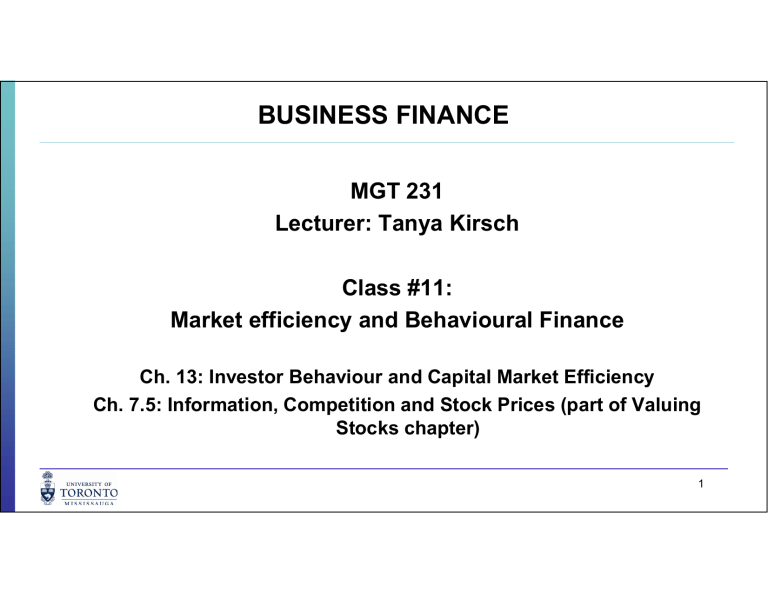
BUSINESS FINANCE MGT 231 Lecturer: Tanya Kirsch Class #11: Market efficiency and Behavioural Finance Ch. 13: Investor Behaviour and Capital Market Efficiency Ch. 7.5: Information, Competition and Stock Prices (part of Valuing Stocks chapter) 1 MARKET EFFICIENCY 2 Deviations from the Security Market Line 3 What is Market Efficiency? An efficient market is a market that reacts quickly and relatively accurately to new public information, which results in prices that are correct on average. Conditions for an Efficient Market 1. A large number of rational, profit-maximizing investors exist, who actively participate in the market by analyzing, valuing and trading securities. The markets must be competitive, meaning no one investor can significantly affect the price of the security through their own buying and selling. 2. Information is costless and widely available to market participants at the same time. 3. Information arrives randomly and therefore announcements over time are not serially connected. 4. Investors react quickly and fully (and reasonably accurately) to the new information, which is reflected in stock prices. Information and Rational Expectations So why are shares ‘mispriced’? • The market portfolio can be inefficient if a significant number of investors either: – Do not have rational expectations so that they misinterpret information and believe they are earning a positive alpha when they are actually earning a negative alpha, or – Care about aspects of their portfolios other than expected return and volatility, and so are willing to hold inefficient portfolios of securities. • This is a violation of the CAPM assumptions 6 Efficiency of the Market Portfolio (Note: This is from Chapter 7) • The efficient market hypothesis (EMH) is the theory that markets are efficient and therefore, in its strictest sense, implies that prices accurately reflect all available information at any given time. • There are three forms of the EMH – which relate to the amount of information that is baked into the current share price: • Weak Form EMH • Semi-strong Form EMH • Strong Form EMH 7 Forms of Market Efficiency 8 Technical Analysis Weak Form EMH Weak Form EMH is the theory that security prices reflect all market data, referring to all past price and volume trading information. Implication: • Markets that are weak-form efficient will have all historical trading data reflected or discounted in current prices and these should be of no value in predicting future prices changes. • Technical analysts look for patterns in stock prices as a way of predicting future prices • If the market is efficient in the weak form, this means that Technical analysis won’t help generate outperformance 10 11 Fundamental Analysis Fundamental analysis is where analysts determine the intrinsic value of a share by analyzing financial statements, the economy, the company’s management and business model, ratios, etc. Semi-strong Form EMH Semi-strong Form EMH is the theory that all publicly known and available information is reflected in security prices. It assumes the weak-form set of information is incorporated as well as all public information pertinent to the security such as: earnings, dividends, corporate investments and management changes. Implication: • Markets that are semi-strong-form efficient will have all publicly available information reflected or discounted in current prices and so it is futile to analyze public information in an attempt to identify mispriced securities. • If the market is efficient in the semi-strong form, this means that fundamental analysis doesn’t help generate performance 13 Strong Form EMH Strong Form EMH is the theory that all public and private information is reflected in security prices. It assumes the weak-form and semi-strong form of information is incorporated as well as all private information Implication: • Markets that are strong-form efficient always have securities that are fairly priced. Therefore, neither publicly available information nor insider information can be used to identify mispriced securities. • This would mean that inside information wouldn’t help generate outperformance 14 Support for Weak Form efficiency in the real world? Support for weak form efficiency? Yes. But: • • Patterns occur too inconsistently to be profitable Transaction costs eliminate profit Anomalies to efficiency: • • • Contrarian investing over the longer term Momentum in share price in the shorter term Seasonal patterns Conclusion: • The weak form holds (i.e. technical analysis “is a waste of time”) 15 Support for Semi-strong Form efficiency in the real world? Support for semi-strong efficiency? Yes. Why? • • Professional fund managers do not consistently outperform the market Transaction costs eliminate profit Anomalies to efficiency: • • Small cap outperform large cap Value stocks outperform growth stocks Conclusion: • • Most studies conclude that the semi-strong form holds But: there are some anomalies 16 Manager Value Added and Investor Returns for U.S. Mutual Funds (1977–2011) The Efficiency of the Market Portfolio • The Performance of Fund Managers – Fund Manager Value-Added • The median mutual fund actually destroys value once you take fees into account • Most fund managers appear to trade so much that their trading costs exceed the profits from any trading opportunities they may find. – Return to Investors • Numerous studies report that the actual returns to investors of the average mutual fund have a negative alpha • Superior past performance is not a good predictor of a fund’s future ability to outperform the market 18 Empirical Evidence Regarding Market Efficiency: Summary 1. Weak form efficiency is very well supported, although a few anomalies do exist 2. Semi-strong form efficient is well supported, but more contradictory evidence exists for this version of the EMH than for the weak form 3. Strong form efficiency is not very well supported by the evidence, and it is reasonable to conclude that markets are not strong form efficient in the strictest sense 19 Implications of Market Efficiency • Empirical evidence suggests: markets react quickly and relatively accurately to new public information • Markets may not be perfectly efficient, but they are relatively efficient Implications for Investors 1. Technical analysis is not likely to be rewarded 2. Fundamental analysis is also unlikely to be successful at generating abnormal profits after transaction costs and taxes 3. Active trading strategies are unlikely to outperform passive, buy-and-hold strategies, favouring index mutual funds or exchange-traded funds (ETFs) 4. Investors should focus on the basics of good investing by defining investment goals in terms of expected returns and acceptable risk levels 20 Market efficiency? 21 RELAXING THE “RATIONAL INVESTOR” ASSUMPTION: BEHAVIOURAL BIASES 22 Behavioural Finance Is there such a thing as a “rational investor”? Do investors: • Consider all available information • Act rationally and do not make systematic errors, either in processing information or in implementing decisions • Adhere to the basic tenets of modern portfolio theory, which implies they are risk averse, they diversify, and they consider risk in the context of a well-diversified portfolio This Photo by Unknown Author is licensed under CC BY-NC-ND Behavioural Finance • Behavioural finance is a field of financial thought that suggests investor behaviour is not always rational but is influenced by psychological biases that cause investors to make systematic errors in judgment • Peter Bernstein: …evidence…“reveals repeated patterns of irrationality, inconsistency and incompetence in the ways human beings arrive at decisions and choices when faced with uncertainty.” 24 The Behaviour of Individual Investors 1. Underdiversification and Portfolio Biases – There is much evidence that individual investors fail to diversify their portfolios adequately. – Why? • Familiarity Bias – Investors favor investments in companies they are familiar with (e.g. shares in their own company) • Relative Wealth Concerns – Investors care more about the performance of their portfolios relative to their peers, so buy shares their friends are talking about 25 The Behaviour of Individual Investors 2. Excessive Trading – According to the CAPM, investors should hold risk-free assets in combination with the market portfolio of all risky securities. There should be minimal trading on a day-to-day basis – In reality, a tremendous amount of trading occurs each day. 26 Individual Investor Returns Versus Portfolio Turnover The Behaviour of Individual Investors 3. Overconfidence Bias – Investors believe they can pick winners and losers when, in fact, they cannot – Leads them to trade too much – Results in them not investing in index funds and risk-free investments (take on too much risk) 28 The Behaviour of Individual Investors 4. Sensation Seeking – An individual’s desire for novel and intense risk-taking experiences. 30 Systematic Trading Biases - Are there patterns in the irrational behavior of individual investors? - If there are patterns that are predictable and systematic, then a sophisticated investor who understands these can make profits Patterns in investor behaviour 1. Hanging on to Losers and the Disposition Effect – Disposition Effect = When an investor holds on to stocks that have lost their value and sell stocks that have risen in value since the time of purchase – Investors don’t want to sell a stock that has gone down because they are “waiting for it to get back to the original price before selling it” 32 Patterns in investor behaviour 2. Investor Attention, Mood and Experience: – Investor Attention: • Studies show that individuals are more likely to buy stocks that have recently been in the news, engaged in advertising, experienced exceptionally high trading volume, or have had extreme returns. – Mood • Sunshine generally has a positive effect on mood, and studies have found that stock returns tend to be higher when it is a sunny day at the location of the stock exchange. – Personal Experience with markets • People who grew up and lived during a time of high stock returns are more likely to invest in stocks than people who experienced times when stocks performed poorly. 33 Patterns in investor behaviour 3. Herd behaviour – When investors make similar trading errors because they are actively trying to follow each other’s behavior • • • • • E.g. if they think they are following others who have superior information “Fear of missing out” Fear of underperforming their peers Reputational risk for professional fund managers if they stray too far from their peers Informational Cascade Effects: Traders ignore their own information hoping to profit from the information of others 34 Bubbles in Asset Prices • Bubbles are significant and generally unwarranted increases in asset prices that lead to unsustainably high price levels • Notable bubbles through history: • • • • Dutch Tulip Bulb Bubble (1636) U.S. Stock Price Bubble (1927 to 1929) Internet Stock Bubble (1995 to 2000) U.S. Real Estate Bubble and Sub-Prime Crisis (2008=>) • In bubbles investors exhibit Behavioural biases: Herd-like behaviour, Overconfidence and Fear of regret if they fail to participate in the bubble 35 POSSIBLE STRATEGIES FOR TRADING WHERE THERE ARE BEHAVIOURAL BIASES 36 Trading if there’s market inefficiency 1. The Size Effect: Small stocks outperforming large stocks: – Small market capitalization stocks have historically earned higher average returns than the market portfolio, even after accounting for their higher betas Trading if there’s market inefficiency 2. High book-to-market stocks (or low Price-to-Book ratios): – High book-to-market outperform – Have historically earned higher average returns than low book-tomarket stocks – Value vs Growth stocks • High book-to-market stocks are value stocks • Low book-to-market stocks are growth stocks • Value stocks tend to have positive alphas, and growth stocks negative alphas Value vs Growth Stocks Value Stocks • Stocks that are cheap, unpopular, down in their luck • High Book-to-market • Find firms priced lower than their fundamental values. • Explore anomalies in market efficiency. Growth Stocks • Shares with an exciting story that are growing quickly • Low Book-to-market • Find firms with high growth potential such as high PE ratio, etc. • Assume market prices in future growth opportunities. 39 Trading if there’s market inefficiency 3. Momentum Effect: – Stocks that have recently performed well continue to perform well, and vice versa – Momentum Strategy to produce alpha: • Buying stocks that have had past high returns and (short) selling stocks that have had past low returns • But: Beware of the bubble! Implications of Positive-Alpha Trading Strategies Why have these trading strategies produced alpha? a) The market portfolio is not efficient, and therefore a stock’s beta with the market is not an adequate measure of its systematic risk. b) Proxy Error – The true market portfolio may be efficient, but the proxy we have used for it may be inaccurate c) Behavioural Biases – By falling prey to behavioural biases, investors may hold inefficient portfolios d) Alternative Risk Preferences and Non-Tradable Wealth – Investors care about risk characteristics other than the volatility – e.g. maybe they are drawn to a stock which has a very high payoff even though it has a low probability of happening Forthcoming attractions • Final exam: Will be written on your laptop computers – same as the midterm • Additional office hours will be posted on Quercus • No tutorials this week 42 Where do we come from? What are we? Where are we going? (Paul Gauguin, 1897) GOOD LUCK!! 43
